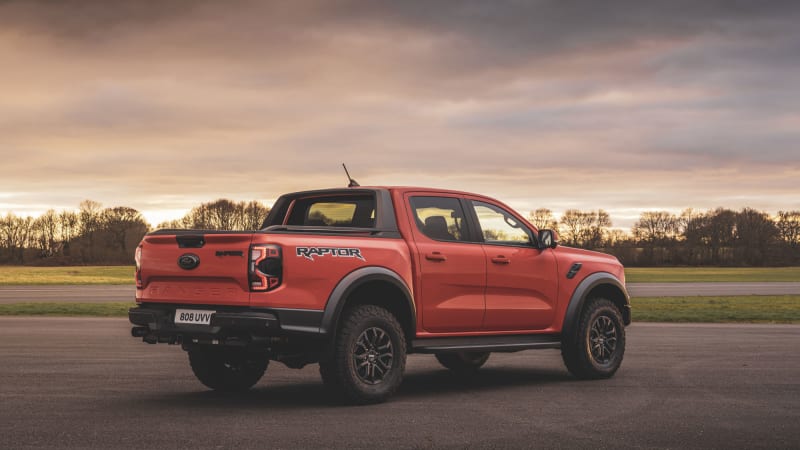Ford has revealed the 2023 Ranger Raptor, the second-generation of the off-road performance pickup truck. And according to Ford CEO Jim Farley, it’s finally coming to America (and Canada). Designed by Ford Performance, the new Raptor packs everything buyers love about the F-150 Raptor in a more compact package.
Yes! Next year. Ranger and Ranger Raptor 🇺🇸
— Jim Farley (@jimfarley98) February 21, 2022
While the last-generation Ranger Raptor sold globally was exclusively offered with a turbodiesel four-cylinder engine, the second-generation model lands with a twin-turbocharged, gas-powered 3.0-liter EcoBoost V6 stuffed between its punched-out fenders. It’s tuned to develop 284 horsepower and 362 pound-feet of torque in European-specification. Roadshow reports that U.S. output will be 392 horsepower and 430 pound-feet of torque. Interestingly, all of these numbers seem to be less than the more than 400 horsepower planned for the Bronco Raptor, which also gets a twin-turbo 3.0-liter V6.
As we predicted, the outgoing truck’s 2.0-liter twin-turbocharged diesel will continue to be available in the Ranger Raptor, though likely not for North America. Its specifications haven’t been announced yet, though it’s rated at 210 horsepower and a stout 368 pound-feet of torque in the original dune-hopping Ranger.
Back to the V6: Ford noted that an anti-lag system similar to the one fitted to the GT and the Focus ST (and aforementioned Bronco Raptor) ensures boost is always there when you need it. It keeps the turbochargers spinning for up to three seconds after the driver’s foot comes off the gas. The engine exhales through an active exhaust system with four different modes, and the familiar 10-speed automatic transmission sends power to the four wheels via a two-speed transfer case plus front and rear locking differentials. Ford explained that the Raptor’s main mission is high-speed off-roading, but the truck is also capable of more traditional (and slower-paced) off-roading — overlanding was one of the use cases engineers had in mind.
Raptor-specific mounts and reinforcements help ensure that the chassis is up to the task of speeding across the desert, and we’re told the suspension system has been completely redesigned. The upper and lower control arms are made from aluminum to keep weight in check, both axles gain more travel, and adjustable Fox 2.5-inch Live Valve shocks with internal bypass technology come standard. One of the many cool features packed into the Raptor is Bottom-Out Control, which maximizes damping force in the final 25% of suspension travel to ensure that the underbody doesn’t have an expensive encounter with a rock. This also prevents the Ranger from squatting as it accelerates. If the Raptor does bottom out, thick skid plates mitigate the damage by protecting most of the vital mechanical components.
Technology is, of course, part of the package. Drivers have seven modes called Normal, Sport, Slippery, Rock Crawl, Sand, Mud/Ruts and Baja to choose from. Each profile modifies parameters like the traction and stability control systems, the ABS sensitivity, the transmission’s shift points, and the throttle response. And, each driving mode is linked to a specific theme in the instrument cluster.
Based on the new Ranger introduced in 2021, the Raptor wears a brawny look characterized by “FORD” lettering in the grille, a shorter front bumper that increases the approach angle, flared wheel arches, and a Raptor emblem on the tailgate. Step inside and you’ll find what Ford refers to as jet fighter-inspired sport seats, Code Orange accents, shift paddles, and a great deal of technology including a 12.4-inch digital instrument cluster, a 12-inch touchscreen and a 10-speaker B&O sound system.
Ford dealers across Europe will begin receiving the Ranger Raptor in the fourth quarter of 2022. Pricing information hasn’t been announced yet. The truck will later come to the U.S. in 2023.
Related Video:
Source: www.autoblog.com

